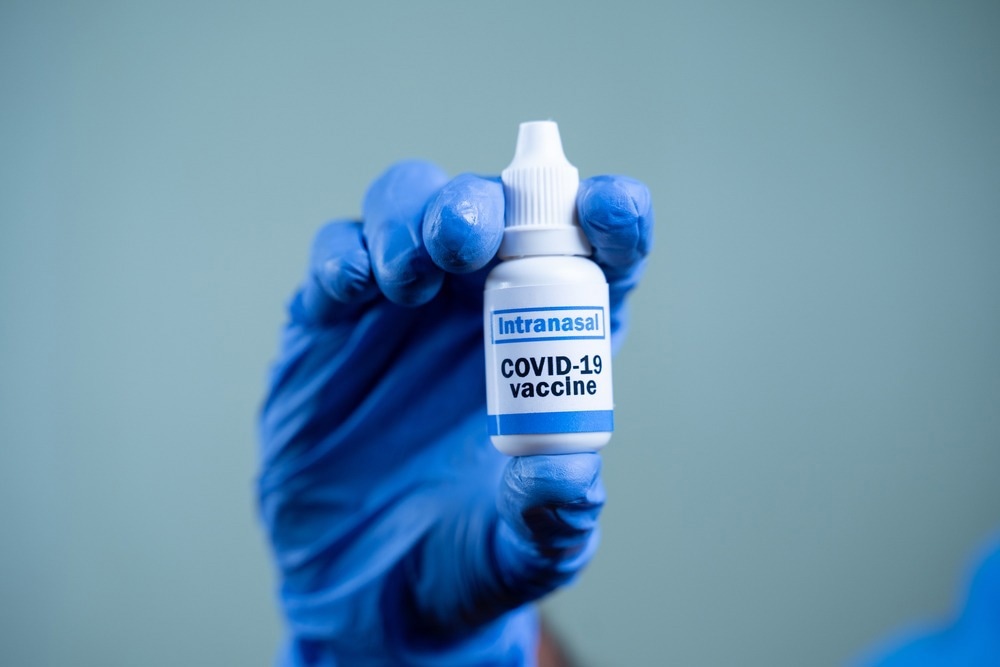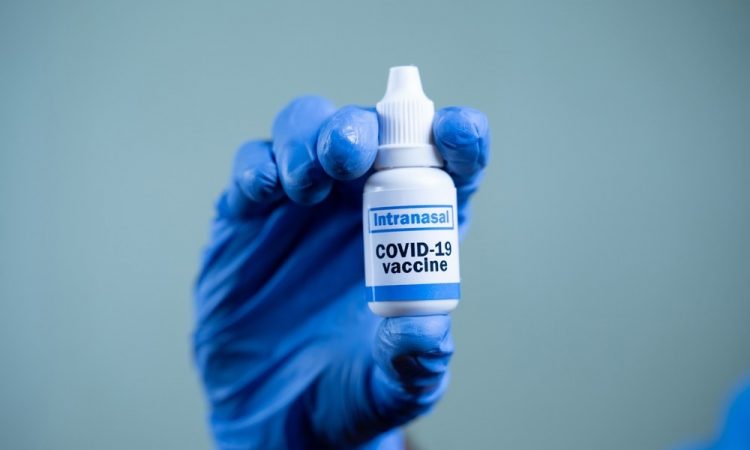In a recent study posted to the bioRxiv* server, researchers evaluated the efficacy of dNS1-RBD, a novel intranasal coronavirus disease 2019 (COVID-19) vaccine.

Background
Nearly 38 currently used COVID-19 vaccines are delivered using intramuscular injection. They confer protection against severe acute respiratory syndrome coronavirus 2 (SARS-CoV-2) mainly by triggering neutralizing antibodies (nAbs) targeting viral spike (S) antigen.
Mass vaccination has effectively reduced SARS-CoV-2 symptomatic infection, hospitalization, and death. However, SARS-CoV-2 uniquely displays anatomical escape in the upper respiratory tract (URT), where nAb titers are 200 to 500 times lower than in the circulation, which makes it impossible to completely block SARS-CoV-2 infection post the peak vaccine-induced immune response period is over.
Furthermore, immunity escaping variants are continuously emerging yet (e.g., Omicron), and SARS-CoV-2 has several animal host reservoirs (e.g., cats, minks, deer). All these factors make SARS-CoV-2 viable to co-exist with humans for many years and pose a continuing threat. Thus, there is a need to continually develop broad-spectrum COVID-19 vaccines that work via different immune mechanisms and delivery routes.
In particular, there is a greater need for vaccines that protect URT locally to respond to SARS-CoV-2 in a timelier manner. Thus, several vaccines that work via respiratory inoculation are under testing in preclinical animal experiments. For instance, an Ad-vectored trivalent intranasal COVID-19 vaccine developed by Zhou Xing et al. has shown broad-spectrum protective effects against several SARS-CoV-2 variants. With demonstrated broad-spectrum efficacy in preclinical experiments, respiratory mucosal vaccines have become an area of great interest for researchers exploring new COVID-19 vaccine candidates.
About the study
In the present study, researchers investigated the immune response triggered by an intranasal spray vaccine based on the non-structural protein 1 (NS1)-deleted H1N1 influenza vector carrying the gene encoding SARS-CoV-2 receptor-binding domain (RBD) called dNS1-RBD. This vaccine demonstrated a good safety profile in phase I and II clinical trials but a weak peripheral immune response. It prevented SARS-CoV-2-induced pathological changes without triggering significant neutralizing antibodies, which is different from the protective mechanism of traditional vaccines.
Since a vaccine could induce a protective immune mechanism via four routes, innate immunity, trained immunity, cellular immune responses covering the URT and LRT, and RBD-targeting antibodies, the researchers evaluated dNS1-RBD efficacy from all four aspects. The team used ribonucleic acid sequencing (RNA-seq) analysis to explore the innate immune response elicited by dNS1-RBD.
They collected 15 samples of mouse lung tissue for RNA-seq analysis. The study group comprised 12 samples from vaccinated mice, collected on 7-, 14- and 28 days post-vaccination (d.p.im). The remaining three samples from unvaccinated mice served as the control group. The team harvested lung immune cells and analyzed them at different time points by flow cytometry (FC).
Furthermore, the researchers used principal component analysis (PCA) to study gene expression levels of genes involved in innate immune pathways and cytokine-related pathways. They also plotted heatmaps to showcase differentially expressed genes (DEGs) in the dNS1-RBD vs. the control group.
Study findings
The primary study finding was that dNS1-RBD vaccination helped the host maintain tissue homeostasis, which provided pathological protection against SARS-CoV-2 by inducing trained immunity with broad-spectrum antiviral and anti-inflammatory effects. Furthermore, dNS1-RBD activated alveolar macrophages, myeloid dendritic cells, and natural killer (NK) cells and remodeled the chromatin openness of these cells.
Since the gene governing the anti-infection immunity of these cells remained open for several months, they remained protected against SARS-CoV-2. The dNS1-RBD vaccination also effectively inhibited SARS-CoV-2 copy numbers by approximately 155-fold, 84-fold, and 10-fold on days 1, 3, and 5, respectively. Briefly, dNS1-RBD reshaped the anti-SARS-CoV-2 immune response pattern by training immune cells and structural cells to attenuate inflammation and confer protection.
Studies have also demonstrated that intranasal immunization with attenuated Bordetella pertussis conferred protection against two influenzas A viruses, further highlighting the importance of trained immunity in non-specific protection at a higher speed. Another remarkable effect of dNS1-RBD vaccination was that it provided good protection within 24 hours. Since it used a truncated NS1, it induced faster and stronger cytokine production. These properties make dNS1-RBD a great emergency vaccine that could be administered early during an endemic outbreak to reduce the COVID-19 burden and cease onward SARS-CoV-2 transmission.
Tissue-resident memory T (TRM) cells provide durable and broad-spectrum immune protection. They are critical for controlling respiratory viral infections and provide timely and stronger protective immunity than circulating T cells. It is of great significance in the context of asymptomatic or mild SARS-CoV-2 infection. The dNS1-RBD vaccine triggered RBD-specific cellular immune responses in the nasal-associated lymphoid tissue (NALT) and lungs on the fifth day after vaccination, which persisted for at least six months in the periphery.
Conclusions
The current study highlighted that dNS1-RBD-like intranasal vaccines could work as a booster in heterologous COVID-19 vaccination regimens. Although dNS1-RBD showed the limited potential of viral clearance, it favorably remodeled the immune microenvironment and trained the immune and structural cells to confer adequate protection in the respiratory tract. Furthermore, it helped maintain the immune balance between the innate immunity arm and the respiratory tissue to attenuate immune-induced tissue injury. Most importantly, it induced broad-spectrum local cellular immunity and trained immunity in the respiratory tract, which is beneficial for coping with newly emerged SARS-COV-2 variants.
*Important notice
bioRxiv publishes preliminary scientific reports that are not peer-reviewed and, therefore, should not be regarded as conclusive, guide clinical practice/health-related behavior, or treated as established information.
- Zhang, L. et al. (2022) "Intranasal delivery of NS1-deleted influenza virus vectored COVID-19 vaccine restrains the SARS-CoV-2 inflammatory response". bioRxiv. doi: 10.1101/2022.10.03.510566. https://www.biorxiv.org/content/10.1101/2022.10.03.510566v1
Posted in: Medical Research News | Medical Condition News | Disease/Infection News
Tags: Antibodies, Antigen, Anti-Inflammatory, Chromatin, Coronavirus, Coronavirus Disease COVID-19, covid-19, Cytokine, Cytometry, Efficacy, Flow Cytometry, Gene, Gene Expression, Genes, H1N1, Immune Response, immunity, Immunization, Inflammation, Influenza, Lungs, Omicron, Pertussis, Preclinical, Protein, Receptor, Respiratory, Ribonucleic Acid, RNA, SARS, SARS-CoV-2, Severe Acute Respiratory, Severe Acute Respiratory Syndrome, Structural Protein, Syndrome, Vaccine, Virus

Written by
Neha Mathur
Neha is a digital marketing professional based in Gurugram, India. She has a Master’s degree from the University of Rajasthan with a specialization in Biotechnology in 2008. She has experience in pre-clinical research as part of her research project in The Department of Toxicology at the prestigious Central Drug Research Institute (CDRI), Lucknow, India. She also holds a certification in C++ programming.
Source: Read Full Article
